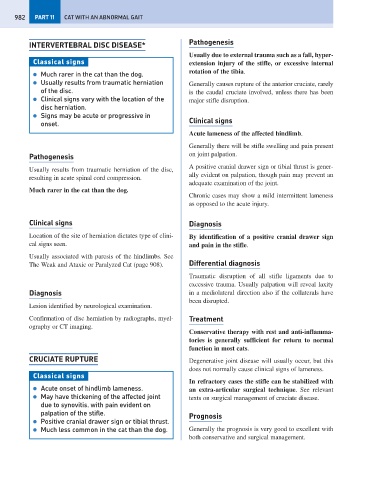Page 990 - Problem-Based Feline Medicine
P. 990
982 PART 11 CAT WITH AN ABNORMAL GAIT
INTERVERTEBRAL DISC DISEASE* Pathogenesis
Usually due to external trauma such as a fall, hyper-
Classical signs extension injury of the stifle, or excessive internal
rotation of the tibia.
● Much rarer in the cat than the dog.
● Usually results from traumatic herniation Generally causes rupture of the anterior cruciate, rarely
of the disc. is the caudal cruciate involved, unless there has been
● Clinical signs vary with the location of the major stifle disruption.
disc herniation.
● Signs may be acute or progressive in
onset. Clinical signs
Acute lameness of the affected hindlimb.
Generally there will be stifle swelling and pain present
Pathogenesis on joint palpation.
A positive cranial drawer sign or tibial thrust is gener-
Usually results from traumatic herniation of the disc,
ally evident on palpation, though pain may prevent an
resulting in acute spinal cord compression.
adequate examination of the joint.
Much rarer in the cat than the dog.
Chronic cases may show a mild intermittent lameness
as opposed to the acute injury.
Clinical signs Diagnosis
Location of the site of herniation dictates type of clini- By identification of a positive cranial drawer sign
cal signs seen. and pain in the stifle.
Usually associated with paresis of the hindlimbs. See
The Weak and Ataxic or Paralyzed Cat (page 908). Differential diagnosis
Traumatic disruption of all stifle ligaments due to
excessive trauma. Usually palpation will reveal laxity
Diagnosis in a mediolateral direction also if the collaterals have
been disrupted.
Lesion identified by neurological examination.
Confirmation of disc herniation by radiographs, myel- Treatment
ography or CT imaging.
Conservative therapy with rest and anti-inflamma-
tories is generally sufficient for return to normal
function in most cats.
CRUCIATE RUPTURE Degenerative joint disease will usually occur, but this
does not normally cause clinical signs of lameness.
Classical signs
In refractory cases the stifle can be stabilized with
● Acute onset of hindlimb lameness. an extra-articular surgical technique. See relevant
● May have thickening of the affected joint texts on surgical management of cruciate disease.
due to synovitis, with pain evident on
palpation of the stifle. Prognosis
● Positive cranial drawer sign or tibial thrust.
● Much less common in the cat than the dog. Generally the prognosis is very good to excellent with
both conservative and surgical management.

